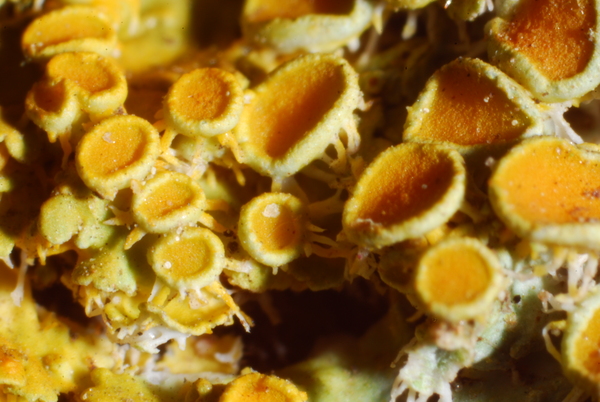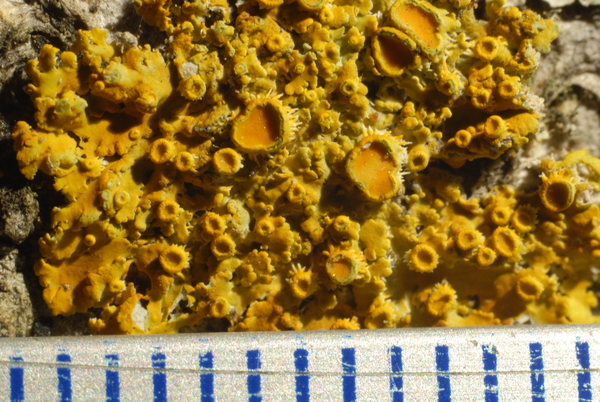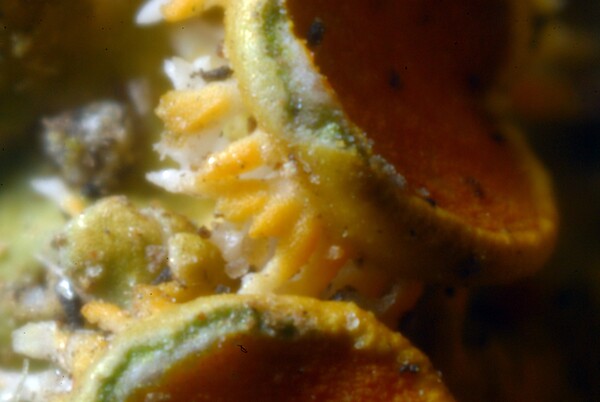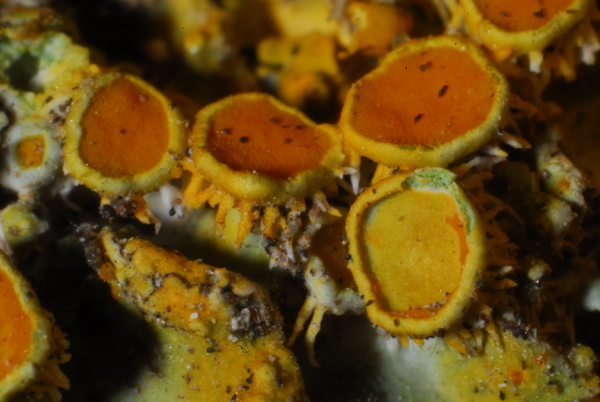Xanthomendoza aphrodites (Kalb, Poelt & S.Y. Kondr.) Søchting, Kärnefelt & S.Y. Kondr.
Mitt. Inst. allg. Bot. Hamburg 30-32: 237, 2002. Basionym: Xanthoria aphrodites Kalb - Poelt & S.Y. Kondr. in Kondratyuk & Poelt, Lichenologist, 29: 180, 1997.
Synonyms:
Distribution: S - Bas (Ravera & al. 2017b), Cal (Puntillo & Puntillo 2015).
Description: Thallus foliose, heteromerous, dorsiventral, yellow to orange, epruinose, forming regular to irregular, sometimes confluent, 1-3(-5) cm wide rosettes. Lobes radiating, 2-4(-7) mm long, 1-1.5(-2) mm wide, flat, densely branched in distal parts to form smaller and thinner lobules. Lower surface whitish, with 0.3-0.7 mm long, 0.05-0.15 mm thick, whitish, mostly submarginal, rarely projecting rhizines. Upper and lower cortex paraplectenchymatous; medulla white. Apothecia usually numerous, (0.3-)0.5-2.5(-3) mm across, sessile and constricted at base, with an orange, concave to flat disc, and a usually paler, raised thalline margin which often bears a few to numerous, white to yellow-orange, rhizine-like, radiating or downward-pointing outgrowths. Thalline exciple paraplectenchymatous; proper exciple a strongly gelatined plectenchyma with unoriented, short-celled hyphae; epithecium orange, K+ purple-red; hymenium colourless, 70-85(-100) µm high; paraphyses 1.5-2(-2.5) µm thick at base, the apical cells swollen; hypothecium colourless, c. 50-90 µm high. Asci 8-spored, clavate, functionally unitunicate, apically thickened with a broad internal beak, the inner part of apex and external cap I+ blue, Teloschistes-type. Ascospores 2-celled, polarilocular, hyaline, broadly ellipsoid, 13-17 x 7-11 µm, the equatorial thickening (“septum”) 5-8 µm. Pycnidia immersed into reddish-orange warts. Conidia bacilliform, 3.5-4.8 x c. 1 µm. Photobiont chlorococcoid. Spot tests: thallus and apothecia K+ purple-red, C-, KC-, P-, UV+ orange. Chemistry: thallus and apothecia with parietin (major), fallacinal (major), emodin, teloschistin (major) and parietinic acid (chemosyndrome A3 of Søchting 1997). Note: a Mediterranean epiphytic species, hitherto known only from Crete, Cyprus and Southern Italy.
Growth form: Foliose, narrow lobed
Substrata: bark
Photobiont: green algae other than Trentepohlia
Reproductive strategy: mainly sexual
Commonnes-rarity: (info)
Alpine belt: absent
Subalpine belt: absent
Oromediterranean belt: absent
Montane belt: very rare
Submediterranean belt: absent
Padanian area: absent
Humid submediterranean belt: very rare
Humid mediterranean belt: very rare
Dry mediterranean belt: absent
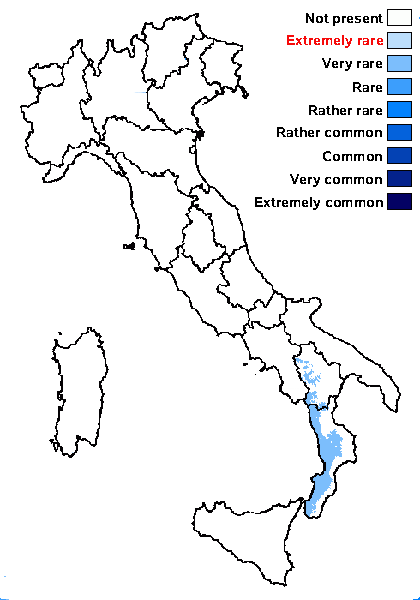
Predictive model
Herbarium samples
Growth form: Foliose, narrow lobed
Substrata: bark
Photobiont: green algae other than Trentepohlia
Reproductive strategy: mainly sexual
Commonnes-rarity: (info)
Alpine belt: absent
Subalpine belt: absent
Oromediterranean belt: absent
Montane belt: very rare
Submediterranean belt: absent
Padanian area: absent
Humid submediterranean belt: very rare
Humid mediterranean belt: very rare
Dry mediterranean belt: absent

Predictive model
| Herbarium samples |
 INDEX FUNGORUM
INDEX FUNGORUM
 GBIF
GBIF
